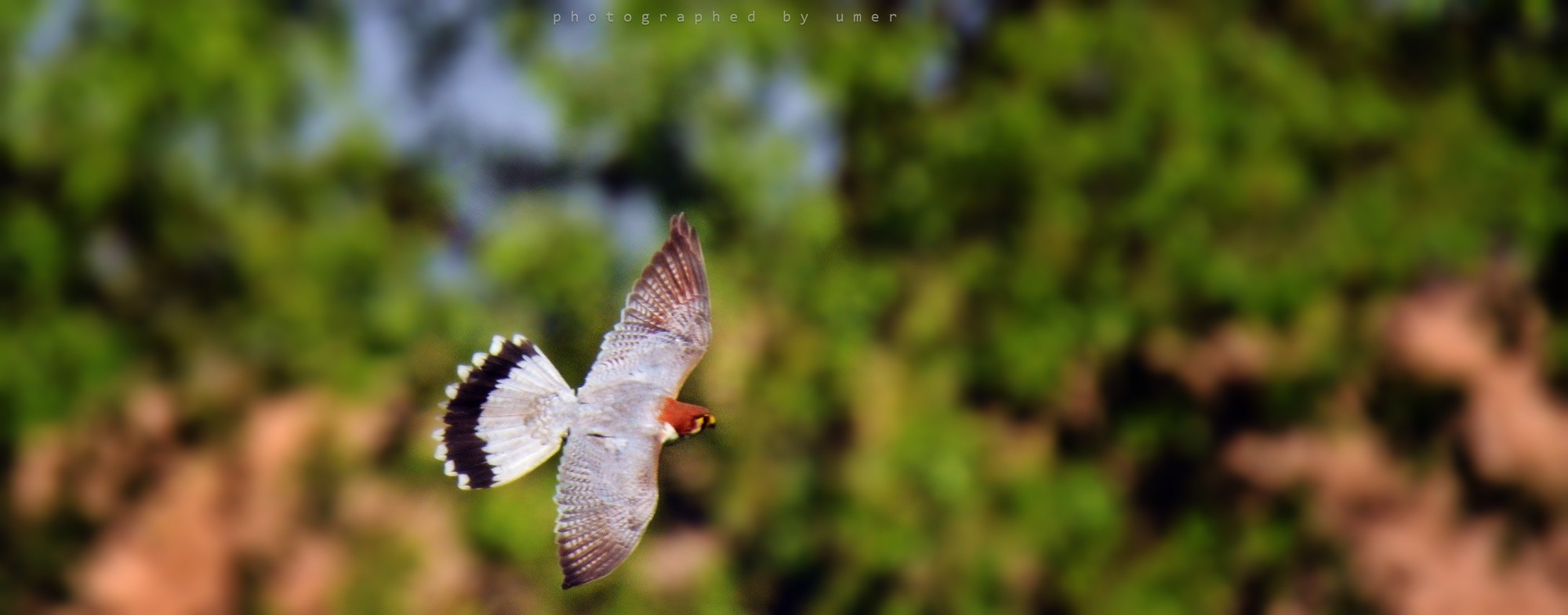Red-necked Falcon
A species of True Falcons Scientific name : Falco chicquera Genus : True Falcons
Red-necked Falcon, A species of True Falcons
Botanical name: Falco chicquera
Genus: True Falcons
Content
Description General Info
 Photo By Tenacious75 , used under CC-BY-SA-4.0 /Cropped and compressed from original
Photo By Tenacious75 , used under CC-BY-SA-4.0 /Cropped and compressed from original Description
The red-necked falcon is a medium-sized, long-winged species with a bright rufous crown and nape. It is on average 30–36 cm in length with a wingspan of 85 cm. The wings and upper parts are bluish grey and the tail has narrow bars, a broad subterminal black band tipped with white. The wingtip does not reach the tip of the tail at rest. The second and third primaries are the longest and almost equal in length while the first is a fourth the length. The first two primaries are notched. The legs, ceres and eyering are yellow. The tip of the bill is black while the basal portion is greenish yellow. The voice of this species is a shrill ki-ki-ki-ki. The sexes are similar except in size, males are smaller than females as is usual in falcons. Young birds are buff below with less extensive barring and duller upper plumage. 
Size
36 cm
Nest Placement
Tree
Feeding Habits
Red-necked Falcon predominantly consumes small birds up to quail size, supplementing its diet with rodents, reptiles, and insects. This dashing hunter captures prey through aerial pursuits or by surprise near waterholes and occasionally stores food. Unique in hunting tactics, red-necked Falcon displays crepuscular peaks during breeding and may pair with other raptors.
Habitat
The red-necked Falcon inhabits open landscapes like semi-deserts, savannahs, and arid regions with sparse trees, often near water. Its environment includes riverine forests to grasslands and floodplains, generally up to 1000 meters in elevation. The presence of palms, such as Borassus and Hyphaene, is significant in these areas. While mostly static, the red-necked Falcon may roam in response to climate changes and demonstrates some adaptability to urban areas.
Dite type
Carnivorous
General Info
Feeding Habits
Bird food type
Behavior
The red-necked falcon usually hunts in pairs, often at dawn and dusk, sometimes utilizing a technique in which one of the pair flies low and flushes up small birds while the other follows higher up and seizes the prey as it flushes from cover. They fly with a fast and dashing flight. It prefers to prey on birds found in open areas and some of the species it has been recorded to hunt are Eurasian tree sparrow (Passer montanus), house sparrow (Passer domesticus), white-browed wagtail (Motacilla madaraspatensis), rosy starling (Sturnus roseus), chestnut-tailed starling (Sturnus malabaricus), Indian cuckoo (Cuculus micropterus), Kentish plover (Charadrius alexandrinus), little ringed plover (Charadrius dubius), ashy-crowned finch-lark (Eremoptrix griseus), besides robins, quails, babblers, swifts, bulbuls, pipits, larks (mainly Calandrella, Alauda, Galerida sp.), pied cuckoo (Clamator jacobinus), rock pigeon (Columba livia), collared dove (Streptopelia decaocto), laughing dove (Streptopelia senegelensis), brown crake (Lanius cristatus), tailor bird (Orthotomus sutorius), brown shrike (Lanius cristatus), white-breasted kingfisher (Halcyon smyrnensis), little stint (Calidris minuta), plain martin (Riparia paludicola) and pied bushchat (Saxicola caprata). In addition mice, lizards, large insects are also taken. In one study in Bangladesh, adults fed mainly on small sparrow sized birds (72%) and Pipistrellus bats (28%). They may sometimes pirate prey obtained by other medium-sized raptors. Prey may sometimes be cached and eaten subsequently. The red-necked falcon drinks water where available during the afternoons. This has been observed both in India and in Africa, where it sometimes visits waterholes. The breeding season in India is January to March. In Zambia, the breeding season begins in August. Pairs may indulge in courtship feeding in which the female feeds the male, an unusual behaviour that has also been noted in captivity. This falcon often reuses the old tree nests of corvids, or lays its 3-5 eggs in a nest that it builds on the fork of a tall tree or in the crown of a palm tree. In Africa, they have been known to reuse the nests of pied crows (Corvus albus), African fish eagles (Halieaetus vocifer) on Acacia apart from building their own nest in Borassus palms. In India, the nest is often placed in a large mango tree (Mangifera indica) and concealed inside foliage. The nest territory is well-guarded and crows and kites driven away. This falcon has been documented to nests in trees amidst dense human population. The clutch consists of two to four eggs which are incubated only by the female which begins after the last egg of the clutch is laid. The eggs hatch after about 32 to 34 days and the newly hatched young are covered in white down and are brooded by the female for a week. The male brings food which is torn by the female and fed to the chicks. The young fledge in about 35 to 37 days in Africa and up to 48 days in India. 
Distribution Area
In Africa, the red-necked falcon is found in semi-desert, savannah and other dry open country with some trees, but also riverine forest. It often perches and makes use of the crowns of Borassus palms (Borassus aethiopum) for breeding. They are mostly resident but may make nomadic movements in response to weather. In India, they are found in open habitats and is not found in dense forests or high hills. The nominate subspecies is believed to have occurred west until Iran although no records exist from there since 1970. They were recorded breeding in 1911 by Nikolai Zarudny. It is a winter vagrant in northern Sri Lanka where it was first recorded by E.L. Layard. 
Species Status
Not globally threatened.
Scientific Classification
Phylum
Chordates Class
Birds Order
Diurnal Birds of Prey Family
Falcons and caracaras Genus
True Falcons Species
Red-necked Falcon